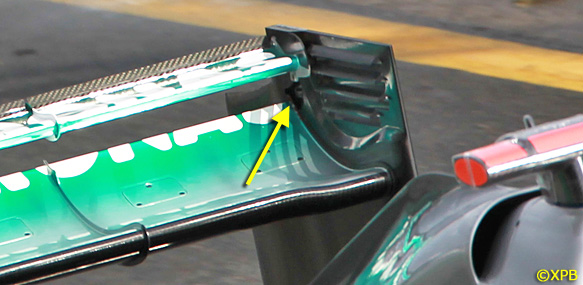I am pretty sure you are incorrect there. Think in terms of an aircraft wing - it stalls BELOW a certain velocity, which is why when a plane takes off it needs to increase speed to generate lift. Extending flaps, etc. lengthens the chord of the wing, allowing it to continue generating lift at a lower velocity.Pup wrote:A little primer on how the f-ducts worked...
First, remember that on a blown wing the blowing prevents the stall - it doesn't cause it to stall. The wing is built in a way that would ordinarily stall, and then the blowing is introduced to prevent it. So on the old McLaren, when the driver 'activated' the f-duct on the straight, he was actually cutting the flow. The gist of this is that there's really no way that the wing duct is involved in the actual blowing, since it opens when you'd want it closed and so would be doing the opposite of what it should. That's why I say that it has to be the switch.
So, flip it over, and below a certain speed the wing on an F1 car is stalled and does not produce downforce. Old-style F-duct blowing did not prevent stalling - it encouraged it. From Scarbs' post on the original F-duct's last iteration in Suzuka 2010:
"Teams have known for a long time that stalling the rear wing drastically reduces downforce and as a result reduces drag. This is because the large flow structures coming off the wing break up and shed the drag inducing effect they have. Many teams have tried to exploit the rules by flexing their rear wings to create just such an effect, but the FIA has outlawed this via a number of deflection tests and latterly the slot gap separator.
McLaren have now found that they can stall the rear wing, if they blow airflow out of a slot at right angles to the underside of the rear wing. But this in itself cannot be exploited unless there is a means to switch the airflow on and off. With the driver controlled F-duct, controlling the flow either to the stalling slot or to a neutral outlet, McLaren can achieve the ideal situation of a downforce wing setting for corners and low drag for the straights."
Looking further at that article, I see what you're saying (Pup) about the fluidic switch - I didn't quite understand correctly how that had worked in the past. I would note, however, that the rear wing holes on the W03 being exits, not intakes, does not mean that they couldn't serve the same function (reducing backpressure down a certain path for the air to divert it). In the case of the W03, though, I don't see where the "neutral outlet" for the airflow would be (that the rear wing holes would "switch" the flow to or from), based on what we know/think so far. What other openings do we see in the rear wing? I suppose that "neutral outlet" could even be supplementary cooling ducts to the radiators, or ducted down to the diffuser for more downforce, or somewhere else hidden by the bodywork and still technically legal for that matter.
On this page of Scarbs's blog, he talks about the 2011 rule changes that effectively banned slots in both the beam wing and the main rear wing (outside of the central 15cm), so something else other than "traditional" slot-blowing of either wing surface has to be happening if it's affecting the rear wing.
All we really "know" right now is that activating the DRS appears to expose holes in the rear wing endplates, there appears to be a duct running through the rear crash structure, Charlie Whiting (who would have as detailed an explanation of the operation and function of the entire system from Mercedes as anyone) has approved the whole system as legal, and another team principal has said that Mercedes has "found a creative solution to circumnavigate" the regulation(s) that resulted in the old-style F-duct being rendered obsolete.
All of the above taken together almost makes me think the solution just might be as simple as it first appears - the holes blow air (ducted through the rear crash structure from some point ahead of it) across the outer edges of the lower face of the upper wing flap to further reduce drag when the DRS is activated. If the "neutral outlet" were sending the air down to the diffuser for more downforce, and that flow were diverted when DRS is activated, it would have the additional effect of reducing downforce in the diffuser when DRS is active. Talk about an aero balance shift, though!
This would maybe allow them to run a more aggressive flap for better downforce in corners when DRS is not active, but would mean they couldn't open the DRS as early in corners during qualifying (because of the proportionally greater loss of rear downforce). It will be interesting to see how early (or not) the Mercedes drivers activate the DRS compared to the other teams in the other practice sessions and qualifying (FP1 was not televised where I live).
Again, all speculation...
Whatever, I'm just happy that the car seems pretty handy so far from FP1! We'll see the real story tomorrow and Sunday, one way or the other.



